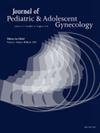10. Improving counseling on treatment options for heavy menstrual bleeding via an educational aid: a pilot study
IF 1.8
4区 医学
Q3 OBSTETRICS & GYNECOLOGY
引用次数: 0
Abstract
Background
Heavy menstrual bleeding (HMB) affects a significant number of reproductive-aged adolescents assigned female at birth (AFAB). There is limited literature examining the use of educational aids (EDA) or videos for adolescent patients initiating hormonal treatment for HMB. EDA could help to eliminate bias and ensure patients receive high-quality information. We hypothesized that use of an EDA would be non-inferior to traditional counseling from a Pediatric and Adolescent Gynecology (PAG) physician on patient's knowledge of treatment options and confidence in method selection
Methods
This is a prospective, randomized controlled trial. IRB approval was obtained. An EDA was created by the PAG department within our institution. Patients AFAB ages 11-21 presenting with a complaint of HMB were recruited to the study. Participants completed a short demographic and knowledge survey and were randomized based on medical record number to traditional versus EDA counseling. Traditional counseling was performed by PAG attendings or fellows. After EDA or traditional counseling, participants completed an additional survey of questions assessing their counseling experience, knowledge of options, and their decision-making process
Results
17 patients were recruited, 8 in the EDA group and 9 in the traditional group. There were no differences between groups in patient ages, race or ethnicity (Table 1). Patients in both groups felt the amount of information they received was “perfect” (p=.76). Patients in the traditional group felt they received more new information compared to the EDA group (p=.02) (Table 1). Both groups felt they learned equally about all options (p=.28). The EDA group answered more post-survey knowledge questions correctly on average compared to the traditional group (p= .02) (Table 1). The traditional counseling group felt significantly more confident than the EDA group when choosing a method (p=.02), though both groups fell into the “confident” range
Conclusions
Patients learned equally about options in both the EDA and traditional counseling groups but felt more confident about choosing an option in the traditional group. EDAs may be a useful tool to eliminate potential bias, improve efficiency in clinic, and increase adolescents’ confidence in making health care choices
10.通过教育辅助工具改进月经大量出血治疗方案的咨询:一项试点研究
背景:大量月经出血(HMB)影响了大量出生时被指定为女性的育龄青少年(AFAB)。有有限的文献研究使用教育辅助(EDA)或视频的青少年患者开始激素治疗HMB。EDA可以帮助消除偏见,确保患者获得高质量的信息。我们假设,在患者对治疗方案的了解和对方法选择的信心方面,使用EDA并不逊于来自儿科和青少年妇科(PAG)医生的传统咨询。获得IRB批准。EDA是由我们机构的PAG部门创建的。研究招募了11-21岁以HMB为主诉的AFAB患者。参与者完成了一项简短的人口统计和知识调查,并根据病历编号随机分为传统和EDA咨询。传统的咨询由PAG主治医师或研究员进行。在接受EDA或传统咨询后,参与者完成了一项额外的调查,评估他们的咨询经验、选择知识和决策过程。结果招募了17名患者,EDA组8名,传统组9名。两组患者在年龄、种族或民族方面没有差异(表1)。两组患者都认为他们收到的信息量是“完美的”(p=.76)。与EDA组相比,传统组的患者认为他们获得了更多的新信息(p= 0.02)(表1)。两组患者都认为他们对所有选项的了解是平等的(p= 0.28)。与传统组相比,EDA组平均正确回答了更多的调查后知识问题(p=.02)(表1)。传统咨询组在选择方法时明显比EDA组更自信(p=.02),尽管两组都属于“自信”范围。结论:患者在EDA和传统咨询组中对选项的了解相同,但在传统组中对选择选项更有信心。EDAs可能是一种有用的工具,可以消除潜在的偏见,提高临床效率,增加青少年做出医疗保健选择的信心
本文章由计算机程序翻译,如有差异,请以英文原文为准。
求助全文
约1分钟内获得全文
求助全文
来源期刊
CiteScore
3.90
自引率
11.10%
发文量
251
审稿时长
57 days
期刊介绍:
Journal of Pediatric and Adolescent Gynecology includes all aspects of clinical and basic science research in pediatric and adolescent gynecology. The Journal draws on expertise from a variety of disciplines including pediatrics, obstetrics and gynecology, reproduction and gynecology, reproductive and pediatric endocrinology, genetics, and molecular biology.
The Journal of Pediatric and Adolescent Gynecology features original studies, review articles, book and literature reviews, letters to the editor, and communications in brief. It is an essential resource for the libraries of OB/GYN specialists, as well as pediatricians and primary care physicians.

 求助内容:
求助内容: 应助结果提醒方式:
应助结果提醒方式:


